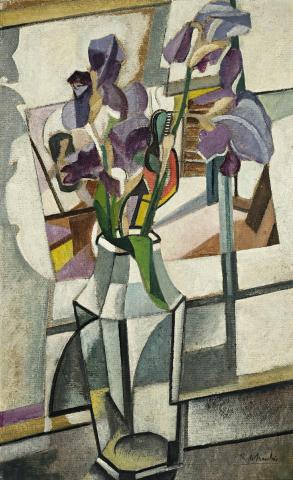STILL LIFE, c.1938
Roy de Maistre
oil on canvas on board
65.5 x 40.0 cm
signed lower right: R. de Maistre
James Fairfax Collection, Sydney
Christie's, Sydney, 25 October 1994, lot 64
Company collection, Melbourne
Possibly Flower Paintings by Roy De Maistre, Calmann Gallery, London, 30 June – 23 July 1938
Johnson, H., Roy de Maistre: The English Years 1930 – 1968, Craftsman House, Sydney, 1995, pp. 107, 108, pl. 44 (illus.)
In Still Life c1938 Roy de Maistre creates a work of cubist fascination, colour and light. As a creation in its own right and not an exercise in verisimilitude, the flowers, vase and setting are but the source of inspiration. This is emphasized by the artist's choice of title in which he does not even mention the type of flower. For de Maistre the elegant beauty of the iris is more important than its name, though its tendrilous inclinations are made to conform with the cubist grid and diagonal tensions within the work. In her monograph of de Maistre, Heather Johnson effectively summarized the artist's achievement. 'De Maistre's ability to divorce himself from his subject matter and use it only as a study of surface pattern, space and colour can be seen in Still Life, undated (Private collection)... where he has reduced the vase to its faceted surfaces - simultaneously a three dimensional object and a flattened part of the geometrically divided background.'1 The more cubist this work the greater is its aesthetic appeal. Illusions of depth flirt with the picture plane, the imaginary the more intriguing by changes in perspective, spatial relationships, and subtle interplay of colours. The nuances of seductive hues - of gentle mauves, touches of yellow, orange and green - are all the more pronounced and appealing by being set within a palette largely made up of the neutrals of white, grey and black. Moreover, the activity of the lines and angles make sure that pictorially this still life is anything but still. This is increased by the compositional high viewpoint and leftwards inclination, counterbalanced by other pictorial and compositional subtleties.
Flowers attracted many a leading twentieth century artist who is usually better known for figure or other painting. De Maistre's contemporary, the British artist Stanley Spencer (1891 - 1959), for example, produced some outstanding paintings of flowers, several very fine examples of which can be seen at Adelaide's Carrick Hill. De Maistre loved flowers. They often decorated his London studio. There was also the exhibition Flower Paintings by Roy de Maistre held at the Calmann Gallery, London in June - July 1938. The eighteen oils and seven pastels in the exhibition included works akin to our painting in their explorations of space, light and colour, as signified by such titles as Study in White and Study in Yellow and Violet. The singular beauty of Still Life c1938 comes from the quality of light with which he has invested it, as from its colours and inventive use of form and space.
1. Johnson, op. cit., p. 107
DAVID THOMAS
